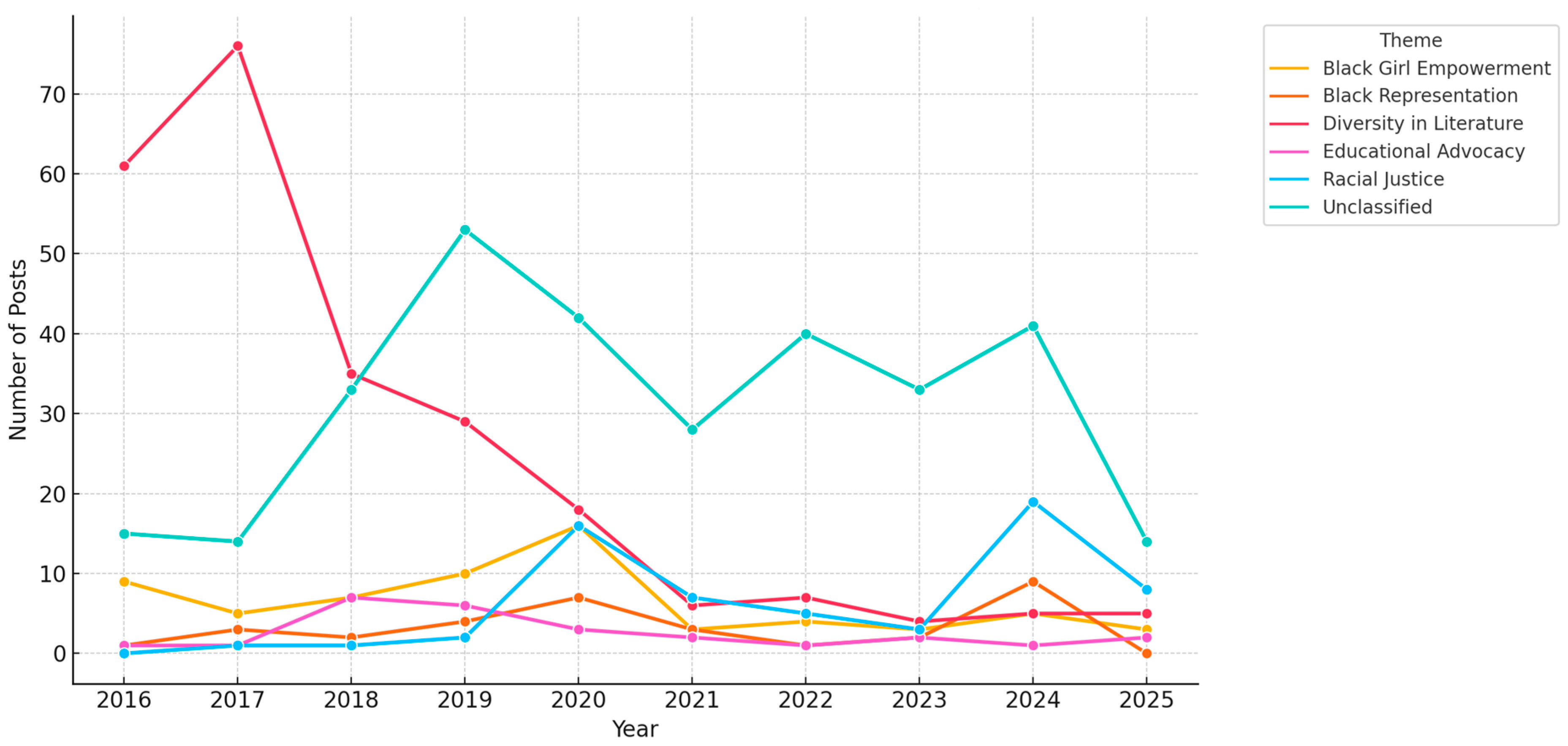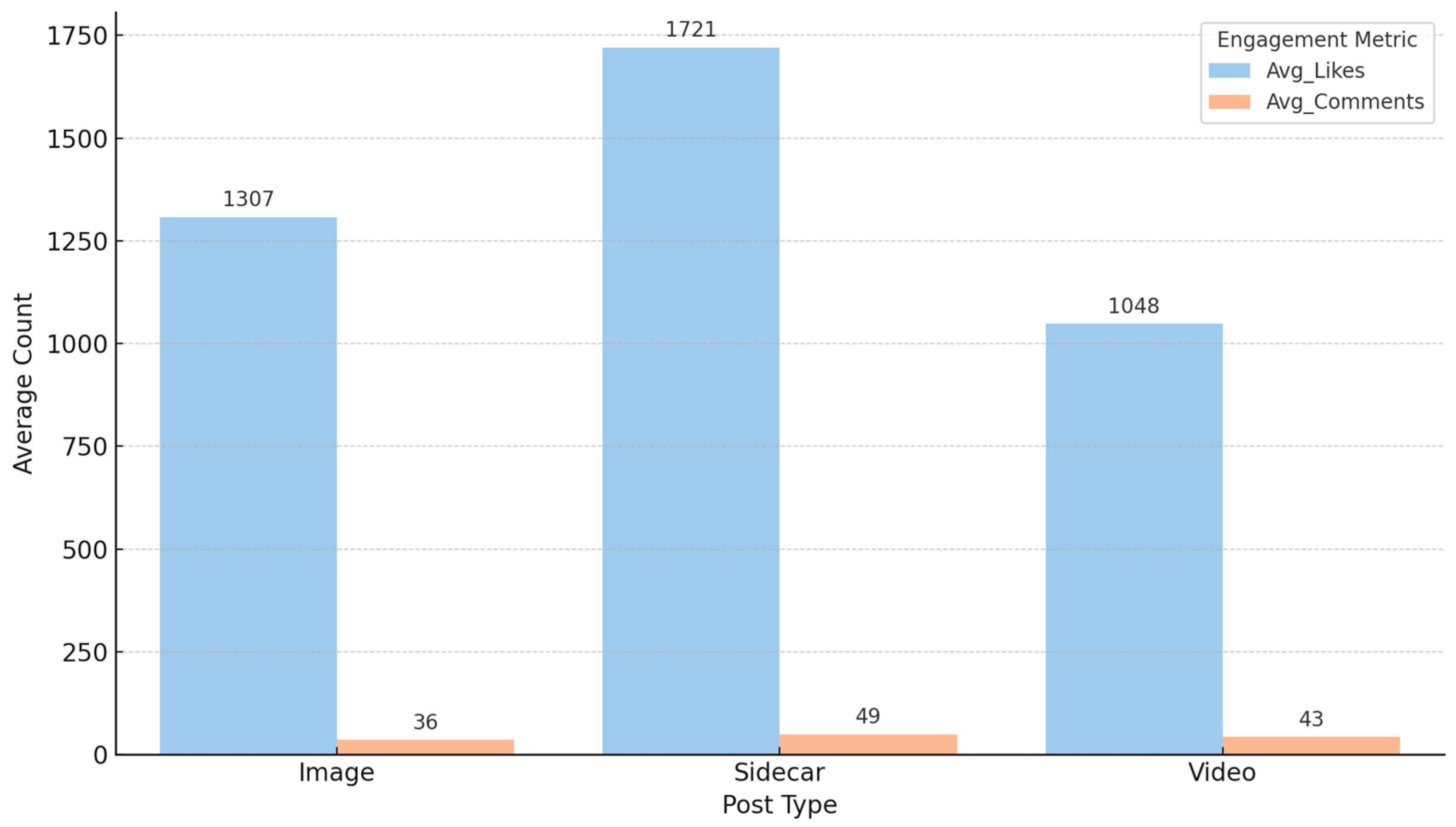Digital Youth Activism on Instagram: Racial Justice, Black Feminism, and Literary Mobilization in the Case of Marley Dias
Abstract
1. Introduction
2. Digital Black Girlhood and Platformed Activism: Epistemic Resistance and Civic Imagination
2.1. Situated Knowledge and Intersectional Injustice
2.2. Digital Counter Publics, Civic Engagement, and Platformed Resistance
2.3. Platform Capitalism, Risk, and the Politics of Visibility
3. Methodology
4. Results
4.1. Thematic Analysis
4.2. Temporal Evolution of Themes
5. Discussion
5.1. Thematic Multiplicity as Black Feminist Counter-Narrative
5.2. Platform Literacy and Narrative Strategy: Instagram as a Political Medium
5.3. Audience Engagement as Affective and Political Participation
6. Conclusions
Author Contributions
Funding
Institutional Review Board Statement
Informed Consent Statement
Data Availability Statement
Conflicts of Interest
References
- Bailey, J., & Steeves, V. (Eds.). (2015). eGirls, eCitizens: Putting technology, theory and policy into dialogue with girls’ and young women’s voices. University of Ottawa Press. [Google Scholar]
- Banet-Weiser, S. (2018). Empowered: Popular feminism and popular misogyny. Duke University Press. [Google Scholar]
- Banet-Weiser, S., & Higgins, K. C. (2022). Television and the “honest” woman: Mediating the labor of believability. Television & New Media, 23(2), 127–147. [Google Scholar] [CrossRef]
- Benjamin, R. (2019). Race after technology: Abolitionist tools for the new Jim code. Polity Press. [Google Scholar]
- Bonilla, Y., & Rosa, J. (2015). #Ferguson: Digital protest, hashtag ethnography, and the racial politics of social media in the United States. American Ethnologist, 42(1), 4–17. [Google Scholar] [CrossRef]
- Boyd, D. (2010). Social network sites as networked publics: Affordances, dynamics, and implications. In Z. Papacharissi (Ed.), A networked self: Identity, community, and culture on social network sites (pp. 39–58). Routledge. [Google Scholar]
- Braun, V., & Clarke, V. (2006). Using thematic analysis in psychology. Qualitative Research in Psychology, 3(2), 77–101. [Google Scholar] [CrossRef]
- Brock, A. (2020). Distributed blackness: African American cybercultures. NYU Press. [Google Scholar]
- Brown, R. N. (2013). Hear our truths: The creative potential of Black girlhood. University of Illinois Press. [Google Scholar]
- Clark, L. S. (2016). Constructing public spaces|participants on the margins: Examining the role that shared artifacts of engagement in the Ferguson protests played among minoritized political newcomers on Snapchat, Facebook, and Twitter. International Journal of Communication, 10, 235–253. [Google Scholar]
- Clark, M. D. (2025). We tried to tell Y’All: Black twitter and the rise of digital counternarratives. Oxford University Press. [Google Scholar]
- Collins, P. H. (2000). Black feminist thought: Knowledge, consciousness, and the politics of empowerment (2nd ed.). Routledge. [Google Scholar]
- Cooper, B. C. (2015). Love no limit: Towards a Black feminist future (in theory). The Black Scholar, 45(4), 7–21. [Google Scholar] [CrossRef]
- Crenshaw, K. (1991). Mapping the margins: Intersectionality, identity politics, and violence against women of color. Stanford Law Review, 43(6), 1241–1299. [Google Scholar] [CrossRef]
- Daniels, J. (2018). The algorithmic rise of the “alt-right”. Contexts, 17(1), 60–65. [Google Scholar] [CrossRef]
- Earl, J., & Kimport, K. (2011). Digitally enabled social change: Activism in the internet age. Mit Press. [Google Scholar]
- Epstein, R., Blake, J. J., González, T., & Johnson, O. (2017). Girlhood interrupted: The erasure of Black girls’ childhood. Georgetown Law Center on Poverty and Inequality. [Google Scholar] [CrossRef]
- Erigha, M., & Crooks-Allen, A. (2020). Digital communities of Black girlhood: New media technologies and online discourses of empowerment. The Black Scholar, 50(4), 66–76. [Google Scholar] [CrossRef]
- Fleetwood, N. R. (2011). Troubling vision: Performance, visuality, and blackness. University of Chicago Press. [Google Scholar]
- Florini, S. (2014). Tweets, tweeps, and signifyin’: Communication and cultural performance on “Black Twitter”. Television & New Media, 15(3), 223–237. [Google Scholar] [CrossRef]
- Fraser, N. (1990). Rethinking the public sphere: A contribution to the critique of actually existing democracy. Social Text, (25/26), 56–80. [Google Scholar] [CrossRef]
- Gill, R., & Orgad, S. (2018). The shifting terrain of sex and power: From the “sexualization of culture” to #MeToo. Sexualities, 21(8), 1313–1324. [Google Scholar] [CrossRef]
- Hammonds, E. (2012). Toward a genealogy of Black female sexuality: The problematic of silence. In M. Jacqui Alexander, & C. T. Mohanty (Eds.), Feminist genealogies, colonial legacies, democratic futures (pp. 170–182). Routledge. [Google Scholar]
- Highfield, T., & Leaver, T. (2016). Instagrammatics and digital methods: Studying visual social media, from selfies to memes. Communication Research and Practice, 2(1), 47–62. [Google Scholar] [CrossRef]
- Hooks, B. (1989). Talking back: Thinking feminist, thinking black. South End Press. [Google Scholar]
- Hooks, B. (1992). Black looks: Race and representation. South End Press. [Google Scholar]
- Ito, M., Baumer, S., Bittanti, M., Boyd, D., Cody, R., Herr-Stephenson, B., Horst, H. A., Lange, P. G., Mahendran, D., Martinez, K. Z., Pascoe, C. J., Perkel, D., Robinson, L., Sims, C., & Tripp, L. (2010). Hanging out, messing around, and geeking out: Kids living and learning with new media. MIT Press. [Google Scholar]
- Ito, M., Soep, E., Kligler-Vilenchik, N., Shresthova, S., Gamber-Thompson, L., & Zimmerman, A. (2020). Learning connected civics: Narratives, practices, infrastructures. In S. Shresthova (Ed.), Cultural production and participatory politics (pp. 10–29). Routledge. [Google Scholar]
- Jackson, S. J., Bailey, M., & Welles, B. F. (2020). # HashtagActivism: Networks of race and gender justice. Mit Press. [Google Scholar]
- Jenkins, H., Shresthova, S., Gamber-Thompson, L., Kligler-Vilenchik, N., & Zimmerman, A. (2016). By any media necessary: The new youth activism. NYU Press. [Google Scholar]
- Leaver, T., Highfield, T., & Abidin, C. (2020). Instagram: Visual social media cultures. John Wiley & Sons. [Google Scholar]
- Livingstone, S., & Third, A. (2017). Children and young people’s rights in the digital age: An emerging agenda. New Media & Society, 19(5), 657–670. [Google Scholar] [CrossRef]
- Marwick, A., & Boyd, D. (2011). To see and be seen: Celebrity practice on Twitter. Convergence, 17(2), 139–158. [Google Scholar] [CrossRef]
- Marwick, A. E., & Boyd, D. (2014). Networked privacy: How teenagers negotiate context in social media. New Media & Society, 16(7), 1051–1067. [Google Scholar] [CrossRef]
- Massanari, A. (2017). # Gamergate and The Fappening: How Reddit’s algorithm, governance, and culture support toxic technocultures. New Media & Society, 19(3), 329–346. [Google Scholar] [CrossRef]
- Medina, J. (2013). The epistemology of resistance: Gender and racial oppression, epistemic injustice, and the social imagination. Oxford University Press. [Google Scholar]
- Mihailidis, P. (2018). Civic media literacies: Re-Imagining human connection in an age of digital abundance. Routledge. [Google Scholar]
- Nash, J. C. (2018). Black feminism reimagined: After intersectionality. Duke University Press. [Google Scholar]
- Noble, S. U. (2018). Algorithms of oppression: How search engines reinforce racism. NYU Press. [Google Scholar]
- Papacharissi, Z. (2015). Affective publics: Sentiment, technology, and politics. Oxford University Press. [Google Scholar]
- Spivak, G. C. (1988). Can the subaltern speak? In C. Nelson, & L. Grossberg (Eds.), Marxism and the interpretation of culture (pp. 271–313). University of Illinois Press. [Google Scholar]
- Warner, M. (2008). Públicos y contrapúblicos (Vol. 5). Universitat Autònoma de Barcelona. [Google Scholar]


| Macro Theme | Posts (N) | % of Total | Image Posts | Video Posts | Carousel Posts |
|---|---|---|---|---|---|
| Diversity in Literature | 246 | 33.06% | 156 | 28 | 62 |
| Black Girl Empowerment | 65 | 8.74% | 23 | 12 | 30 |
| Racial Justice | 62 | 8.33% | 11 | 13 | 38 |
| Black Representation | 32 | 4.3% | 14 | 3 | 15 |
| Educational Advocacy | 26 | 3.49% | 12 | 3 | 11 |
| Unclassified | 313 | 42.07% | 111 | 37 | 165 |
| Macro Theme | Avg Likes | Avg Comments | Avg Total Engagement | N |
|---|---|---|---|---|
| Diversity in Literature | 1204.40 | 26.02 | 1230.41 | 246 |
| Black Girl Empowerment | 1764.94 | 55.20 | 1820.14 | 65 |
| Racial Justice | 1257.10 | 32.95 | 1290.05 | 62 |
| Black Representation | 1854.50 | 47.41 | 1901.91 | 32 |
| Educational Advocacy | 1429.19 | 38.19 | 1467.38 | 26 |
| Unclassified | 1581.66 | 54.53 | 1636.19 | 313 |
Disclaimer/Publisher’s Note: The statements, opinions and data contained in all publications are solely those of the individual author(s) and contributor(s) and not of MDPI and/or the editor(s). MDPI and/or the editor(s) disclaim responsibility for any injury to people or property resulting from any ideas, methods, instructions or products referred to in the content. |
© 2025 by the authors. Licensee MDPI, Basel, Switzerland. This article is an open access article distributed under the terms and conditions of the Creative Commons Attribution (CC BY) license (https://creativecommons.org/licenses/by/4.0/).
Share and Cite
Amaral, I.; Ventura, D. Digital Youth Activism on Instagram: Racial Justice, Black Feminism, and Literary Mobilization in the Case of Marley Dias. Journal. Media 2025, 6, 104. https://doi.org/10.3390/journalmedia6030104
Amaral I, Ventura D. Digital Youth Activism on Instagram: Racial Justice, Black Feminism, and Literary Mobilization in the Case of Marley Dias. Journalism and Media. 2025; 6(3):104. https://doi.org/10.3390/journalmedia6030104
Chicago/Turabian StyleAmaral, Inês, and Disakala Ventura. 2025. "Digital Youth Activism on Instagram: Racial Justice, Black Feminism, and Literary Mobilization in the Case of Marley Dias" Journalism and Media 6, no. 3: 104. https://doi.org/10.3390/journalmedia6030104
APA StyleAmaral, I., & Ventura, D. (2025). Digital Youth Activism on Instagram: Racial Justice, Black Feminism, and Literary Mobilization in the Case of Marley Dias. Journalism and Media, 6(3), 104. https://doi.org/10.3390/journalmedia6030104






